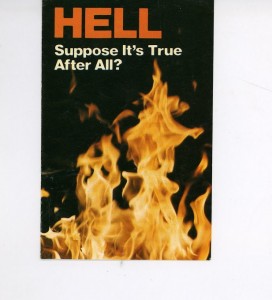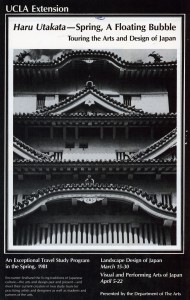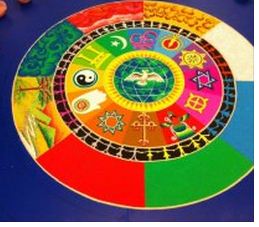Over breakfast this morning, while reading “Mapmaking in the World” in a History of World Societies, my attention was riveted on the Ebstorf Map which was drawn in the thirteenth century. Originally, it was drawn on thirty sheets of vellum and measured about 12 feet in diameter. The original did not survive a bombing of Hanover, Germany in 1943 during WWII. Fortunately, extensive photographs had been taken of it prior to that. What caught my attention was the shape of this map and its orientation. It immediately reminded me of Elaine Robson’s artist Gurme’s rendition of the Christian wheel of existence which was held by Yamantaka, the Tibetan god of death, whose grasp was broken by the sacrificial death of Jesus Christ on the cross.
Archives for 0
Sacred Geography The Ebstorf Map and the Tibetan Sand Mandala
Remembering Wally Tope A Martyr on American Soil
November 21, 2013
Remembering Wally Tope: A Martyr on American Soil
Martyred for his faith during the 1992 Los Angeles Riots. In Remembrance of his passing into glory twenty years ago on November 24, 1993 after suffering eighteen months in a coma.
by James C. Stephens
“He knows the way I take; when He has tested me, I will come forth as gold.”
~Job 23:10
In May 1992, a friend of ours, Wally Tope was dramatically struck down in the prime of his life by two looters he was preaching to in the L.A. Riots. For three days no one knew of his whereabouts and then one Sunday afternoon, I received a call from hospital officials who had found my business card in his personal effects.
They asked, “Are you James Stephens?”
“Do you know Wally Tope?”
“Yes,” I replied. “Why?”
“He’s been hurt badly. Would you mind coming down and identifying him?”
“Certainly.” I was in shock. It seemed that just days before we had been talking about his latest research project on Tibetan Buddhism and the apologetic he was working on.
The next 48 hours were among the most difficult hours I recall in my life. Awaking at 2:00am, I began chronicling the damage in my journal, “For the last two days in Los Angeles there have been over 42 people killed, 1700 people injured; 300 on the critical list, over 3,000 separate fires set to structures, and over $500,000,000 worth of damage to property, not including the tremendous shame of looting, taking of innocent blood, and political opportunism. God has allowed judgment of this City of Los Angeles & County and country rightly.”
The streets of Los Angeles had been deserted because of martial law and the curfew. As I drove, it was through mostly deserted eerie smoke filled streets passing barricades to the hospital where he lay. I took the elevator up to intensive care, not knowing what I would find. The bright flourescent lights of the room strangely illuminated the partially shrouded body of what appeared to be Wally Tope who laid in an unfamiliar stone silence on the narrow hospital bed. “Yes. It is Wally.” I provided a positive identification of his body. From that first moment when I knew it was Wally, I felt I was standing in the presence of one of the first martyrs on American soil. I witnessed firsthand the price of preaching the Gospel and the graphic and brutal hostility of the world to the redeeming truth of Jesus.
Unconscious, black and blue from the blows he received on his head, swollen almost beyond recognition, his brother now arrived and tearfully pulled back the sheets to look at his legs where more bruises were applied by his attackers after being struck on the head and falling to the ground at a Sav’ On Drug in Hollywood. As we spent time in the room before Wally’s body his brother wrestled with his grief attempting to make sense of this tragedy. The old hymn raced through my mind, “By the blood of burning martyrs, Jesus’ bloody feet I track.” Was this Wally, or was it the light of Jesus now in this man I saw? A witness fulfilling the sufferings of Jesus. Eighteen months later never having regained consciousness, he left this world into the presence of Jesus, where he will receive a martyr’s crown.
 The footprint of the legacy that Wally left behind is immense. Well-researched, incisive, accurate, and Biblical characterized each piece of literature that he crafted to convey the Gospel to Mormon’s and Jehovah Witnesses whom he desired would know the Savior Jesus Christ. Often accompanied by one tract, “Hell, Suppose It’s True After All?” evoked a solemn warning about the price of rejecting the message of the Messiah.
The footprint of the legacy that Wally left behind is immense. Well-researched, incisive, accurate, and Biblical characterized each piece of literature that he crafted to convey the Gospel to Mormon’s and Jehovah Witnesses whom he desired would know the Savior Jesus Christ. Often accompanied by one tract, “Hell, Suppose It’s True After All?” evoked a solemn warning about the price of rejecting the message of the Messiah.
There are lessons here for us. One couple realized that the pursuit of the America dream was not along the “King’s highway.” They choose instead to dedicate their lives to service in Asia. Wally had given up a lucrative career as a brilliant engineer and lived a frugal life operating out of a small studio apartment in Pasadena. Saving money to do the LORD’s work wherever it took him around the world. Tragedies inspire deep reflection in those who have known the afflicted or have since heard his testimony around the world. I have one of his bookshelves near my desk, a quiet monument reminding me of the cost of discipleship.
His memorial service on November 24, 1993, some twenty years ago was attended by several hundred people who had been touched by his ministry to the LORD. It can be said that he finished well and heard from His Master, “Well done, good and faithful servant.”
Journal of a Young Buddhist Radical Part II
 In April 1981, I journeyed to Japan on a study tour with UCLA Extension on the Gardens of Japan meeting various architects and landscape architects, some who were in the process of restoring historic gardens. We also visited many historic sites ranging from Tokyo’s Imperial Palace, to the Ise Shrine, Todaiji Temple in Nara, Nijyo Castle, the Golden Temple and Nanzenji Temple in Kyoto to name a few. (For an audio file follow the highlighted link ~approximately 15 minutes). Journal of a Young Buddhist Radical Part II
In April 1981, I journeyed to Japan on a study tour with UCLA Extension on the Gardens of Japan meeting various architects and landscape architects, some who were in the process of restoring historic gardens. We also visited many historic sites ranging from Tokyo’s Imperial Palace, to the Ise Shrine, Todaiji Temple in Nara, Nijyo Castle, the Golden Temple and Nanzenji Temple in Kyoto to name a few. (For an audio file follow the highlighted link ~approximately 15 minutes). Journal of a Young Buddhist Radical Part II
Journal of Young Buddhist Radical
(Click the highlighted link to hear a brief spiritual autobiography. Approximately 3 minutes.)
Photo: In 1970, the General Director George M. Williams, aka Masayasu Sadanaga of Nichiren Shoshu Academy, now known as SGI (Soka Gakkai International), visited California State University Northridge and gave a talk on Buddhism which I and several other members attended, among them Russ Dilando, Carol Dell, Jim Jay, Lance Stromsoe, and Mike Maeda. Steve Gore leaning over in the background was one of General Director Williams’ special assistants who accompanied him to his speaking engagements.

The Buddhist Next Door
The Buddhist Next Door
By James C. Stephens
Little Lisa on The Simpsons Christmas special, tired of the hypocrisy and commercialism of the Springfield church, decides to become a Tibetan Buddhist and is mentored by Richard Gere on prime-time television.
About the same time, John Altschuler, the producer and writer for King of the Hill, is given a book on the Buddha by his wife. He ends up writing a satire for an episode he nicknames, “He Ain’t Heavy, He’s My Buddha.” In this episode, the Hills’ only child, Bobby, is recognized as an American reincarnation of the Lama Sanglug by immigrant monks, putting his father, Hank, through great angst as he unsuccessfully attempts to explain his Methodist worldview to his son. Ever so subtly, and, sometimes blatantly, Buddhism slips in uninvited to comfortable living rooms across America via mainstream media.
This influx of popular Buddhism began in 1960, when Masayasu Sadanaga (George M. Williams), a young student from Japan, stepped onto the UCLA campus with the resolve to introduce “true Buddhism” to America.
In 1970, I was swept up into the excitement of their movement to establish world peace through human revolution while studying political science on the campus of Cal State University Northridge. Thus began my 14-year journey into Buddhism, complete with many practices similar to evangelical Christianity-street witnessing, late-night discussion meetings and the singing of Buddhist sutras set to tunes such as “I’ve Been Working on the Railroad.”
My Buddhist worldview was challenged, however, while visiting Japan on an architecture tour. As I leaned over to put some postcards in my travel bag, someone yelled a warning at me in Japanese. Unfortunately, I didn’t speak Japanese, nor did I have time to move as a 200-pound sign blew over on my back. In shock, I was whisked away in a taxi to the hospital, suffering from a sharp blow to my spinal chord and a partially paralyzed arm. Ironically, the accident report read, “Act of God.”
While lying on several hospital beds in Japan, I struggled with troubling questions about the power of the Buddhist gods to save. After returning to the states, I joined Amway and became consistently exposed to the testimonies of Christians, and observed the importance faith played in their business and marriages. Initially, my wife and I just became more committed to becoming the first successful Buddhist distributors. Evidently, God had other plans.
The following three years were spent aggressively pursuing my business goals, while rubbing shoulders with godly friends who prayed for me, asked me convicting questions and gave me books that answered many of mine. After a month of frightening dreams, weighing the numerous prophecies of Christ with those of the Buddha and wrestling with 2 Peter 3:10 that spoke of the day of the Lord coming like a thief, I sought out a pastor who led me to Christ one hot July afternoon in 1984.
I began to thirst for more than fellowship. Weekly, I searched the church library looking for answers on issues that were of importance to me as a former Buddhist. I searched for books on Christian meditation, but found only those suggesting that Zen meditation made them better Christians. (I knew Zen from my studies and practice, and even as a new Christian saw it as incompatible with the Christian faith.)
This ideology is not confined to books alone. One friend claims that he was healed by his Zen priest’s treatments. Now at his doctor’s advice, he’s practicing Buddhist meditation at home-albeit with a twist: He uses the Lord’s prayer instead of praying to the Buddha. Although claiming to have a love of Christ, he has a very limited understanding of the theological underpinnings of his faith.
This confusion may be traced to the fact that a high percentage of evangelicals no longer believe in the exclusivity of the Christian faith. Instead, according to an August 2005 Beliefnet.com poll, “Eight in 10 Americans-including 68 percent of evangelicals-believe that more than one faith can be a path to salvation, which is most likely not what they were taught in Sunday school.”
Buddhist theology and practice is antithetical to biblical Christianity. For instance, the Buddhist objective in meditation is to empty one’s mind while seeking union with the cosmos, ultimately buying into the Serpent’s ancient lie, “You shall become as gods.”
Since we have already been saved through His grace, we don’t meditate to accumulate merit as would a Buddhist. Through contemplation, we focus our minds on His Word and His works, waiting upon Him and actively listening. Christian meditation takes discipline, but is only fruitful by the grace of God (see 2 Cor. 3:5; 9:8).
So, why do so many Christians neglect to share their faith with Buddhists? Many have willfully chosen to follow the latest popular religious fashions and put their theological mind on hold. According to research by Robert Wuthnow and Wendy Cadge published in Journal for the Scientific Study of Religion (September 2004), “Fifty-six percent of the American public thinks of Buddhists as tolerant, while 63 percent believe them to be peace-loving.”
In its August 2005 survey, Beliefnet.com posed the question, “Can a good person who isn’t of your religious faith go to heaven or attain salvation, or not?” Brace yourself for a shock. While 91 percent of Catholics said yes and 83 percent of non-evangelical Christians said yes, 68 percent of evangelicals said yes as well. Consider how elements of Buddhist ideology have become entwined in our thinking:
A youth pastor at a prominent evangelical church recently rose to the pulpit and gave a report on the success of their recent summer camp. He exclaimed, “It was so great, I thought I died and gone to nirvana.”
Another day, our children-keenly tuned to sniff out Buddhism’s subtle invasion into our culture-shared that their favorite history teacher who was teaching on world religions passed around a little fat Buddha statue and jokingly taught them to rub it for good luck. All this in a preppy private Christian high school in Southern California.
Another friend of mine occasionally travels to India and relayed a story about the many Pentecostals and charismatics he met there who were practicing Tibetan Buddhism. When I asked why, he said, “Most were seeking spiritual experiences, and while they loved Jesus as a teacher, they were not firmly grounded in the Scriptures and went astray as they sought the supernatural.”
We’ve also seen Baptists, Catholics, Methodists, Presbyterians, Episcopalians and Congregationalists slide into Buddhism. One pastor of a local church joined his wife in taking vows at the local Buddhist temple-while retaining his position as senior pastor of the church.
The primary struggle for every generation that is dedicated to missions and evangelism is coming to terms with how does the true gospel get translated into mainstream culture without compromise? How do we keep our faith and maintain our moral and theological standards while still living in the midst of an increasingly pluralistic society?
When an invasive pop culture and its terminology has become the norm, and millions are spent on conveying that message through the media, one cannot passively sit back and live in a 1950s religious cocoon. Daniel and his followers in Babylon faced similar tests of their faith. We are told that the godly will be persecuted. The question is, “Will we remain faithful?”

